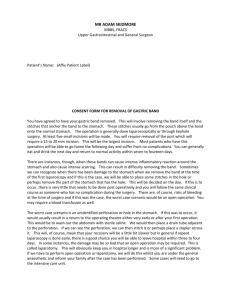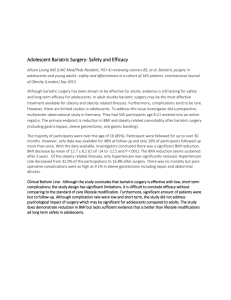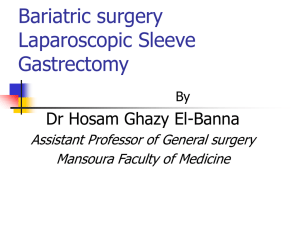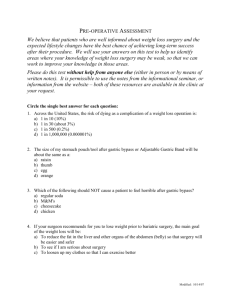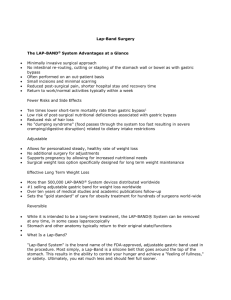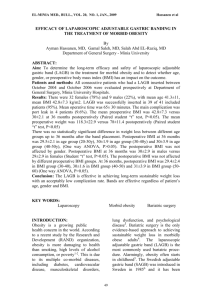informed consent for placement of adjustable gastric banding for
advertisement
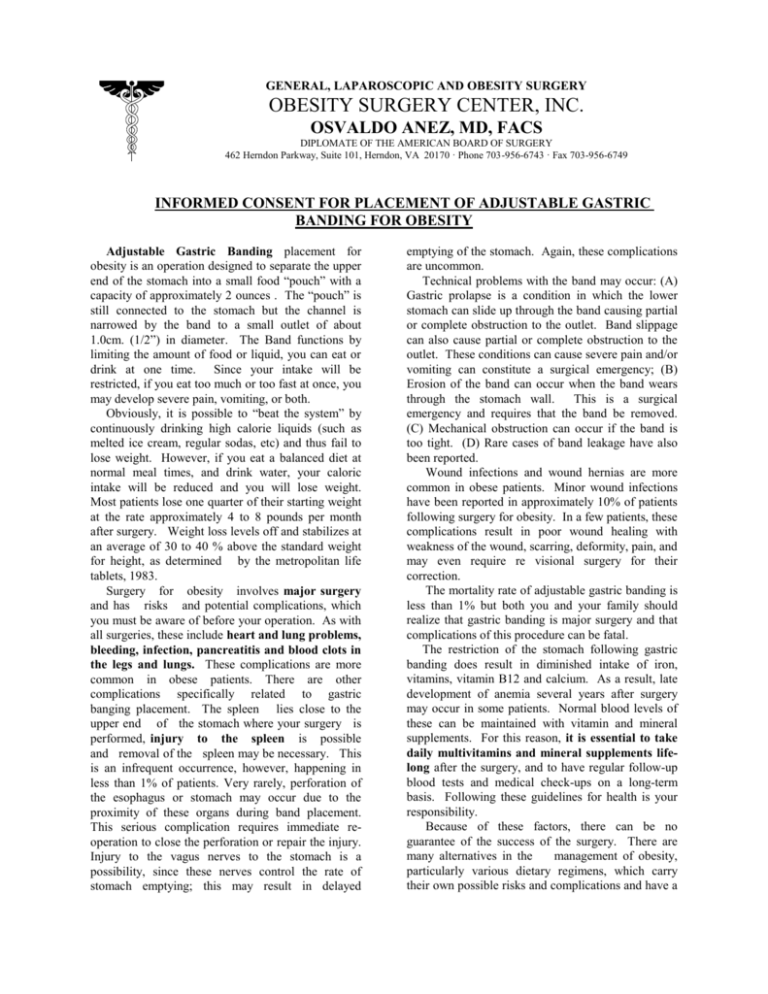
GENERAL, LAPAROSCOPIC AND OBESITY SURGERY OBESITY SURGERY CENTER, INC. OSVALDO ANEZ, MD, FACS DIPLOMATE OF THE AMERICAN BOARD OF SURGERY 462 Herndon Parkway, Suite 101, Herndon, VA 20170 · Phone 703-956-6743 · Fax 703-956-6749 INFORMED CONSENT FOR PLACEMENT OF ADJUSTABLE GASTRIC BANDING FOR OBESITY Adjustable Gastric Banding placement for obesity is an operation designed to separate the upper end of the stomach into a small food “pouch” with a capacity of approximately 2 ounces . The “pouch” is still connected to the stomach but the channel is narrowed by the band to a small outlet of about 1.0cm. (1/2”) in diameter. The Band functions by limiting the amount of food or liquid, you can eat or drink at one time. Since your intake will be restricted, if you eat too much or too fast at once, you may develop severe pain, vomiting, or both. Obviously, it is possible to “beat the system” by continuously drinking high calorie liquids (such as melted ice cream, regular sodas, etc) and thus fail to lose weight. However, if you eat a balanced diet at normal meal times, and drink water, your caloric intake will be reduced and you will lose weight. Most patients lose one quarter of their starting weight at the rate approximately 4 to 8 pounds per month after surgery. Weight loss levels off and stabilizes at an average of 30 to 40 % above the standard weight for height, as determined by the metropolitan life tablets, 1983. Surgery for obesity involves major surgery and has risks and potential complications, which you must be aware of before your operation. As with all surgeries, these include heart and lung problems, bleeding, infection, pancreatitis and blood clots in the legs and lungs. These complications are more common in obese patients. There are other complications specifically related to gastric banging placement. The spleen lies close to the upper end of the stomach where your surgery is performed, injury to the spleen is possible and removal of the spleen may be necessary. This is an infrequent occurrence, however, happening in less than 1% of patients. Very rarely, perforation of the esophagus or stomach may occur due to the proximity of these organs during band placement. This serious complication requires immediate reoperation to close the perforation or repair the injury. Injury to the vagus nerves to the stomach is a possibility, since these nerves control the rate of stomach emptying; this may result in delayed emptying of the stomach. Again, these complications are uncommon. Technical problems with the band may occur: (A) Gastric prolapse is a condition in which the lower stomach can slide up through the band causing partial or complete obstruction to the outlet. Band slippage can also cause partial or complete obstruction to the outlet. These conditions can cause severe pain and/or vomiting can constitute a surgical emergency; (B) Erosion of the band can occur when the band wears through the stomach wall. This is a surgical emergency and requires that the band be removed. (C) Mechanical obstruction can occur if the band is too tight. (D) Rare cases of band leakage have also been reported. Wound infections and wound hernias are more common in obese patients. Minor wound infections have been reported in approximately 10% of patients following surgery for obesity. In a few patients, these complications result in poor wound healing with weakness of the wound, scarring, deformity, pain, and may even require re visional surgery for their correction. The mortality rate of adjustable gastric banding is less than 1% but both you and your family should realize that gastric banding is major surgery and that complications of this procedure can be fatal. The restriction of the stomach following gastric banding does result in diminished intake of iron, vitamins, vitamin B12 and calcium. As a result, late development of anemia several years after surgery may occur in some patients. Normal blood levels of these can be maintained with vitamin and mineral supplements. For this reason, it is essential to take daily multivitamins and mineral supplements lifelong after the surgery, and to have regular follow-up blood tests and medical check-ups on a long-term basis. Following these guidelines for health is your responsibility. Because of these factors, there can be no guarantee of the success of the surgery. There are many alternatives in the management of obesity, particularly various dietary regimens, which carry their own possible risks and complications and have a varying degree of success. Surgical treatment is a management alternative and should be considered as such. It is not an absolute cure-all and does not affect the underlying causes of obesity whether psychological, physical, environmental, familial or hormonal. In most cases, however, surgery is successful in achieving weight loss. Consent for Blood and Blood Product Transfusions. 1. I have had the opportunity to ask questions of the physician and understand the risks, benefits, and alternatives involved in transfusion therapy. 2. I consent to transfusion of all blood/blood products I consent to transfusion with the following exceptions: I refuse all transfusion and blood/blood products. I HAVE READ OR HAD READ TO ME THE CONTESTS OF THIS FORM AND HAVE RECEIVED A COPY. I UNDERSTAND AND THE RISKS AND ALTERNATIVES INVOLVED. I HAVE NO FURTHER QUESTIONS AND WISH TO PROCEED WITH ADJUSTABLE GASTRIC BANDING SURGERY. DATE: _________________________________ ______________________________________________ PRINT NAME ___________________________________________ SIGNED BY PATIENT DATE: ____________________________________ ______________________________________________ PRINT NAME ____________________________________________ SIGNED BY WITNESS DATE: ____________________________________ ______________________________________________ PRINT NAME ____________________________________________ PHYSICIAN SIGNATURE
